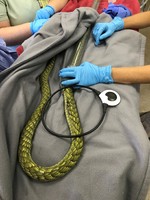About Jacksonville Zoo and Gardens

For over 100 years, the Jacksonville Zoo and Gardens has aimed to inspire the discovery and appreciation of wildlife through innovative experiences in a caring environment. Starting in 1914 with an animal collection of one red deer fawn, the Zoo now has more than 2,000 rare and exotic animals and 1,000 species of plants, boasting the largest botanical garden in Northeast Florida. The Jacksonville Zoo and Gardens is a nonprofit organization and a portion of every ticket sold goes to the over 45 conservation initiatives Jacksonville Zoo and Gardens supports around the world, and here in NE Florida. JZG is proud to be an accredited member of the Association of Zoos and Aquariums.
Dr. Meredith Persky and Dr. Yousuf Jafarey are staff veterinarians that bring years of experience. Dr. Persky went to The Ohio State University for veterinary medicine and was the intern at the Indianapolis Zoo. She completed 2 years of a residency at the Kansas City Zoo. Before joining the team at the Jacksonville Zoo and Gardens she was the staff veterinarian for Zoo Miami. Dr. Yousuf Jafarey graduated from Western University for veterinary medicine and was the intern at the Toledo Zoo before joining them as an associate veterinarian for 2 more years prior to joining the team at the Jacksonville Zoo and Gardens he was the staff veterinarian at Zoo Miami.
Caring for a pet after surgery can be a challenge but is often straightforward. Administering medications and the Assisi Loop® requires diligence, but they’re not particularly difficult tasks.
The story changes when your patient is a highly venomous West African green mamba snake. At Assisi Animal Health, we love helping house pets like dogs, cats or rabbits, but it’s especially exciting when a case with a unique animal crosses our path; we have worked with clients who have treated lion cubs for Wobblers Disease, a bird for inflamed feet and have received fantastic images of Loops treating penguins, eagles, and sharks. Our relationship with the Jacksonville Zoo and Gardens in Florida has afforded the opportunity to hear about even more unique cases with exotic animals.
 Vera, a green mamba snake, is about 20 years old. Related to the infamous and beautiful East African black mamba, the green mamba is generally considered more “shy” – but only a bit less venomous. In October 2017, caretakers noticed that Vera had a swelling about a third of the way down her body, and she was taken into the clinic for exploratory surgery.
Vera, a green mamba snake, is about 20 years old. Related to the infamous and beautiful East African black mamba, the green mamba is generally considered more “shy” – but only a bit less venomous. In October 2017, caretakers noticed that Vera had a swelling about a third of the way down her body, and she was taken into the clinic for exploratory surgery.
Like any other animal would be, she was fitted with a face mask and sedated for the exam. Doctors discovered a large adenocarcinoma, a type of tumor that typically forms on glandular structures on organs, on her liver. The mass was too adhered to remove completely, so doctors “de-bulked” it, removing as much volume as they could before closing up the incision. This type of procedure is painful in humans, so of course it is in animals as well; as a result, doctors administered a number of medications: Meloxicam and a fentanyl patch (for pain), ceftiofur crystalline free acid and Ceftazidime (antibiotics), and the non-invasive, non-pharmaceutical anti-inflammatory device (NPAID®), the Assisi Loop.
 The zoo staff writes in their case report that “due to safety factors, the Loop was prescribed once weekly for five treatments.” (Indeed, it seems that the less handling of a wild and venomous snake, the better.) The report continues: “For the first two weeks the Loop was placed under the enclosure of the patient while she was resting. The sequential three treatments were performed while the snake was being fed in the enclosure.”
The zoo staff writes in their case report that “due to safety factors, the Loop was prescribed once weekly for five treatments.” (Indeed, it seems that the less handling of a wild and venomous snake, the better.) The report continues: “For the first two weeks the Loop was placed under the enclosure of the patient while she was resting. The sequential three treatments were performed while the snake was being fed in the enclosure.”
Since metal lessens the treatment field’s effectiveness of the Assisi Loop, the enclosure through which Vera was treated was plastic or glass, sometimes with a layer of newspaper. The electromagnetic field passes through these kinds of barriers to effectively treat soft tissue.
This is also significantly fewer treatments than the Loop is recommended for when treating domestic pets (for post-surgical healing, treating the site 3-4 times daily for 15 minutes is standard protocol), but the zoo believes that the therapy administered was still beneficial to Vera’s surgical site as part of a multi-pronged approach to healing.
 “The surgical site healed well and without discharge or dehiscence,” the case report reads. “The treatment with the Loop was part of a multimodal approach to analgesia and post-surgical wound therapy. This non-invasive technique provided an additional means of caring for the surgical site and may have provided additional pain relief while assisting with wound healing. Therefore, we would value the opportunity to use the Loop as part of our routine treatment protocol.”
“The surgical site healed well and without discharge or dehiscence,” the case report reads. “The treatment with the Loop was part of a multimodal approach to analgesia and post-surgical wound therapy. This non-invasive technique provided an additional means of caring for the surgical site and may have provided additional pain relief while assisting with wound healing. Therefore, we would value the opportunity to use the Loop as part of our routine treatment protocol.”
Assisi Animal Health takes great pride in the relief the Assisi Loop can provide for animals with painful surgical sites, and thanks to the Jacksonville Zoo and Gardens for its documentation of this unique case.
